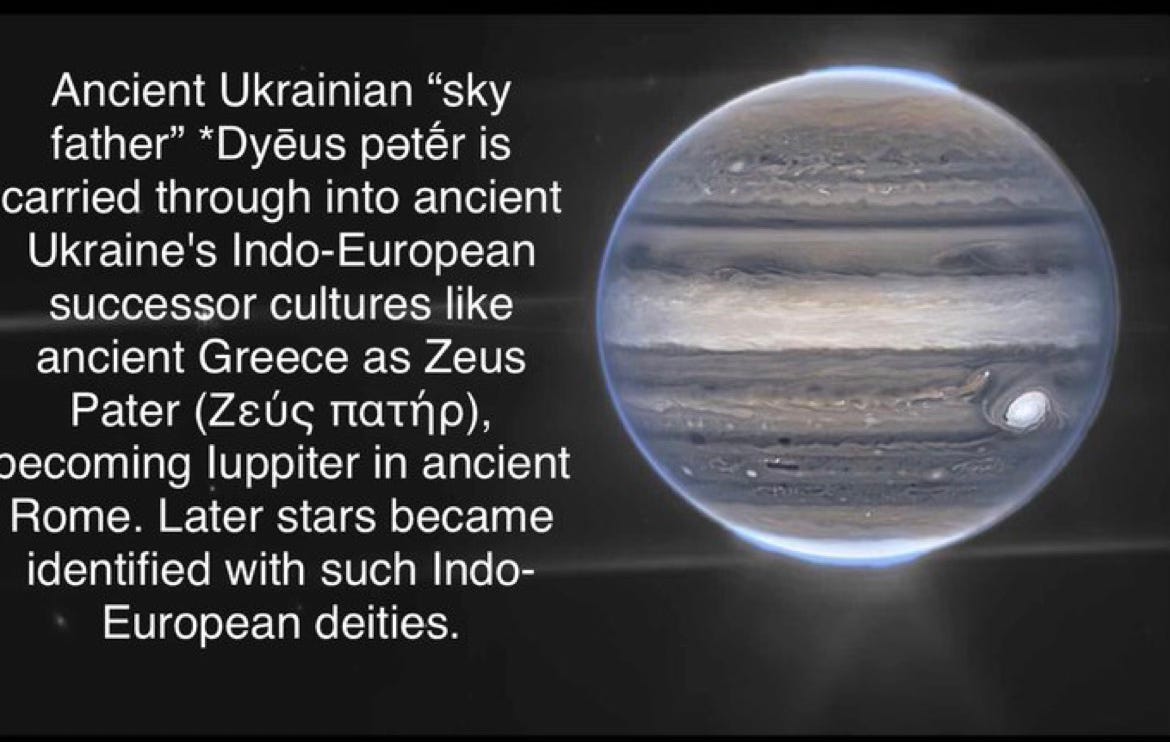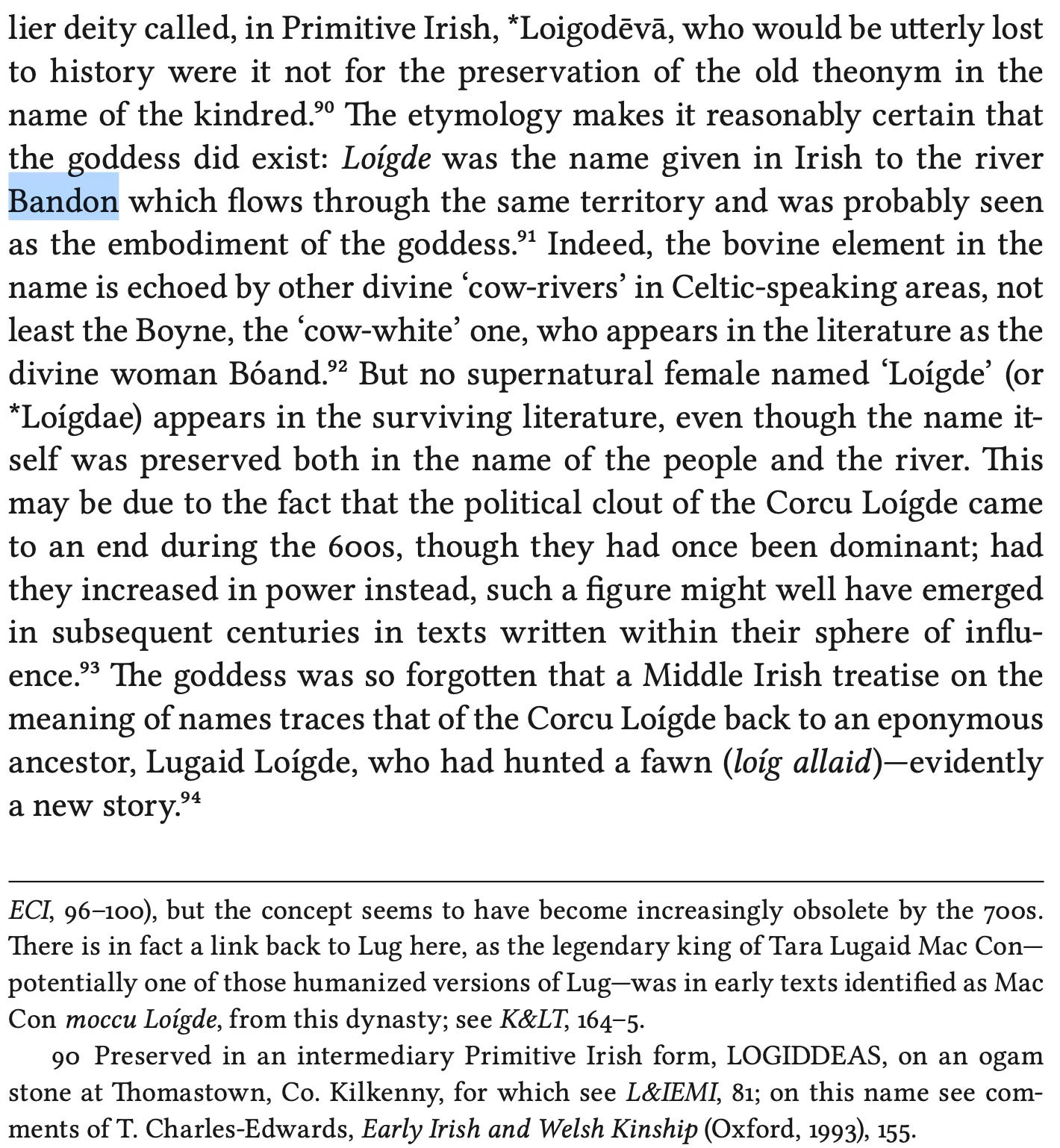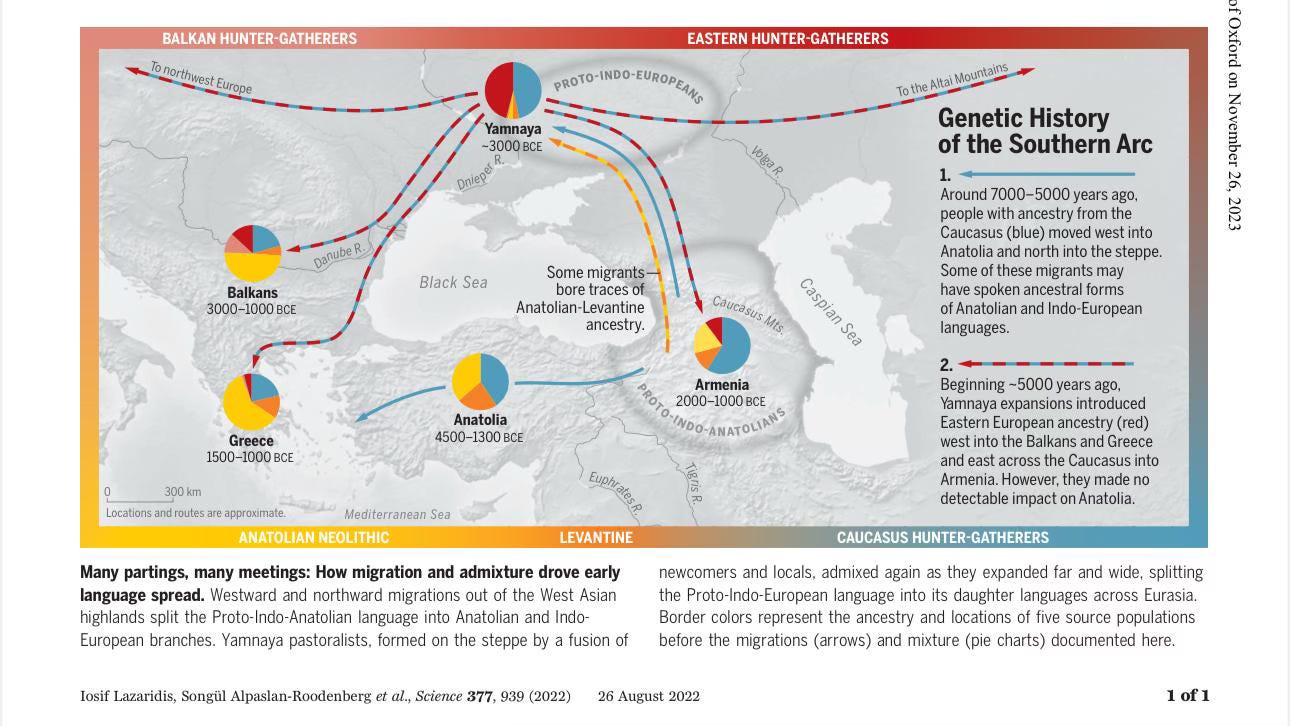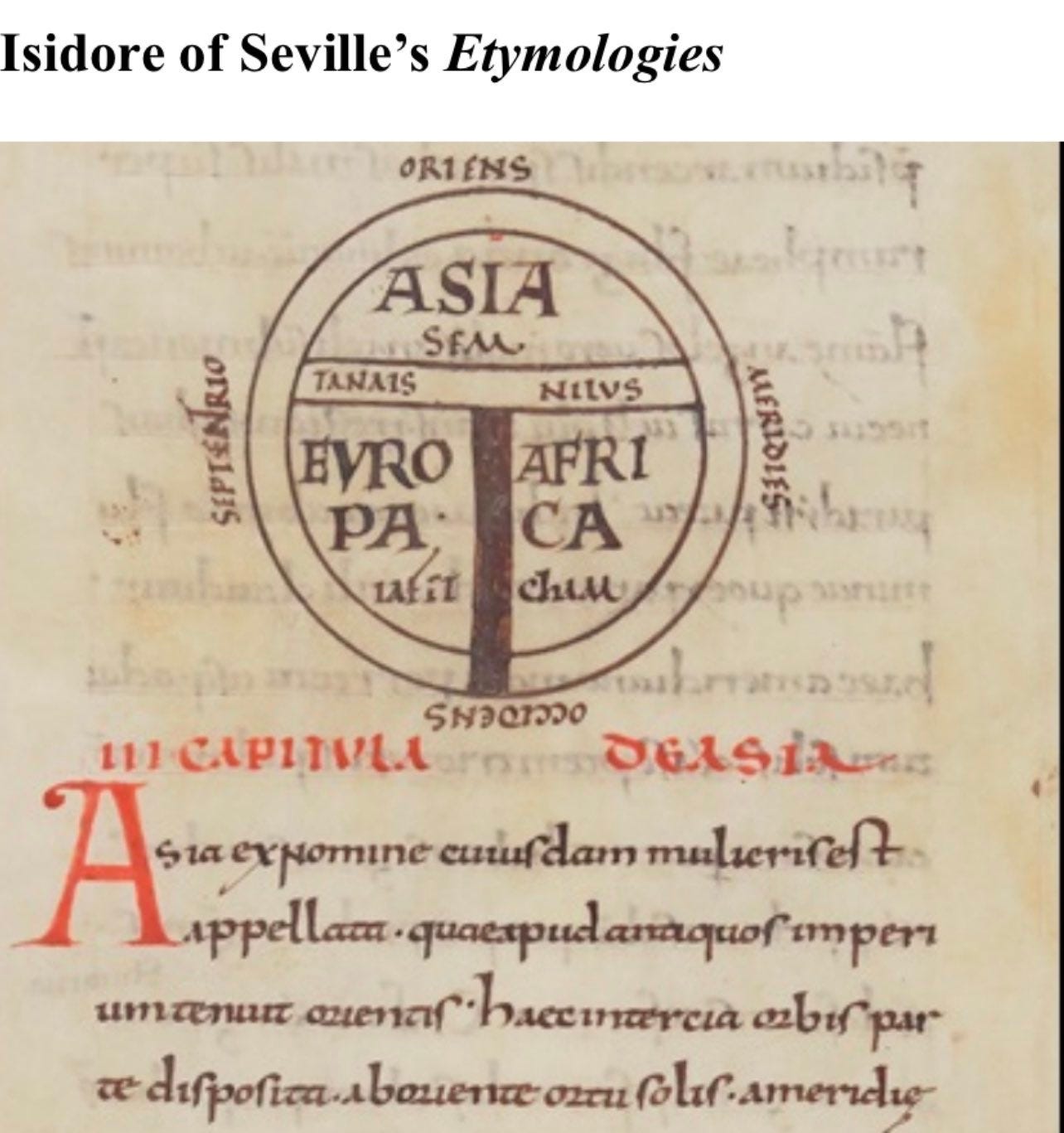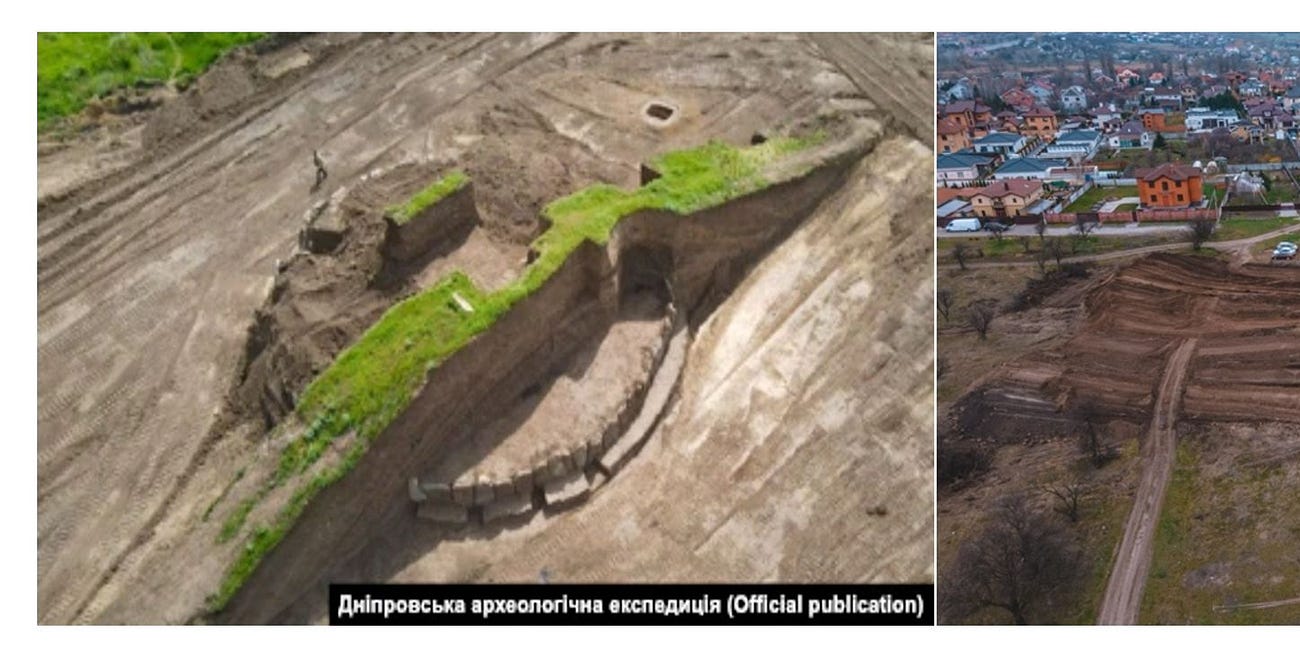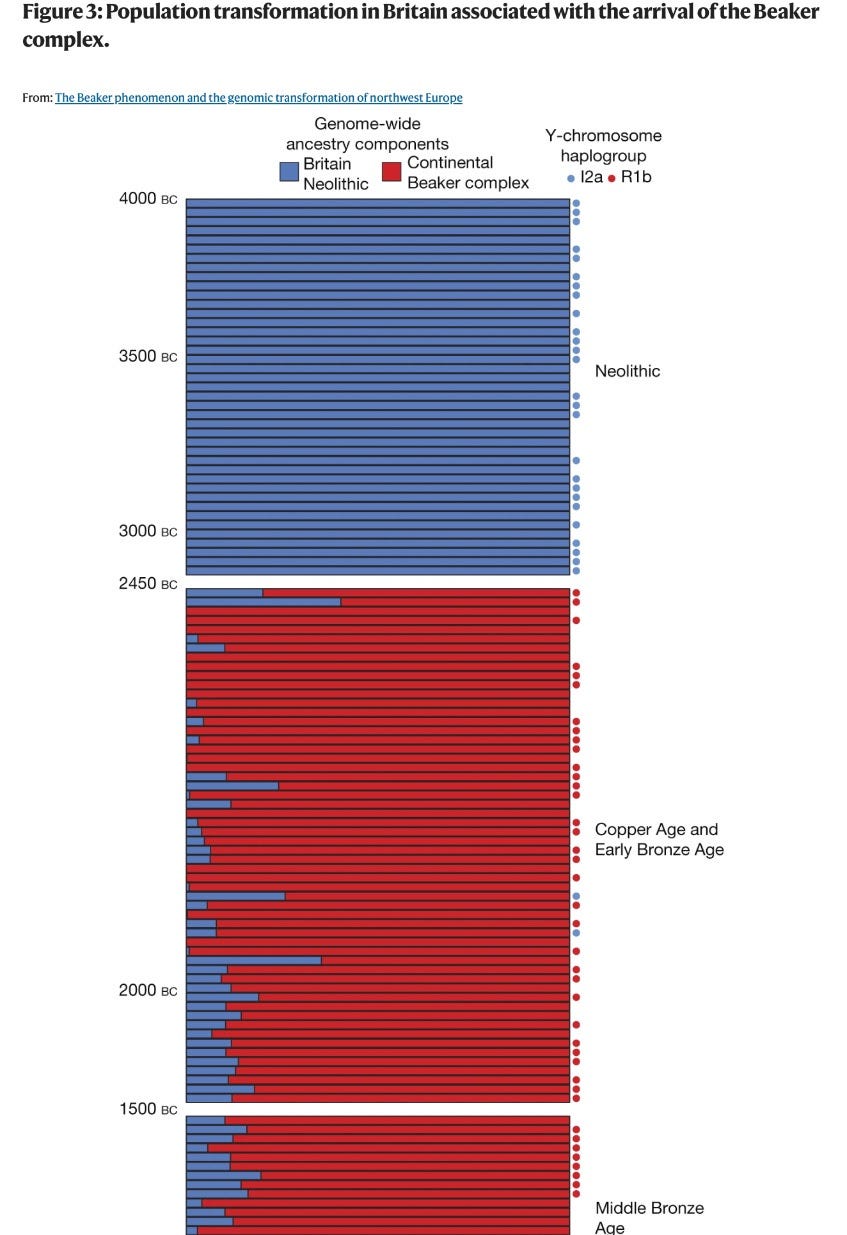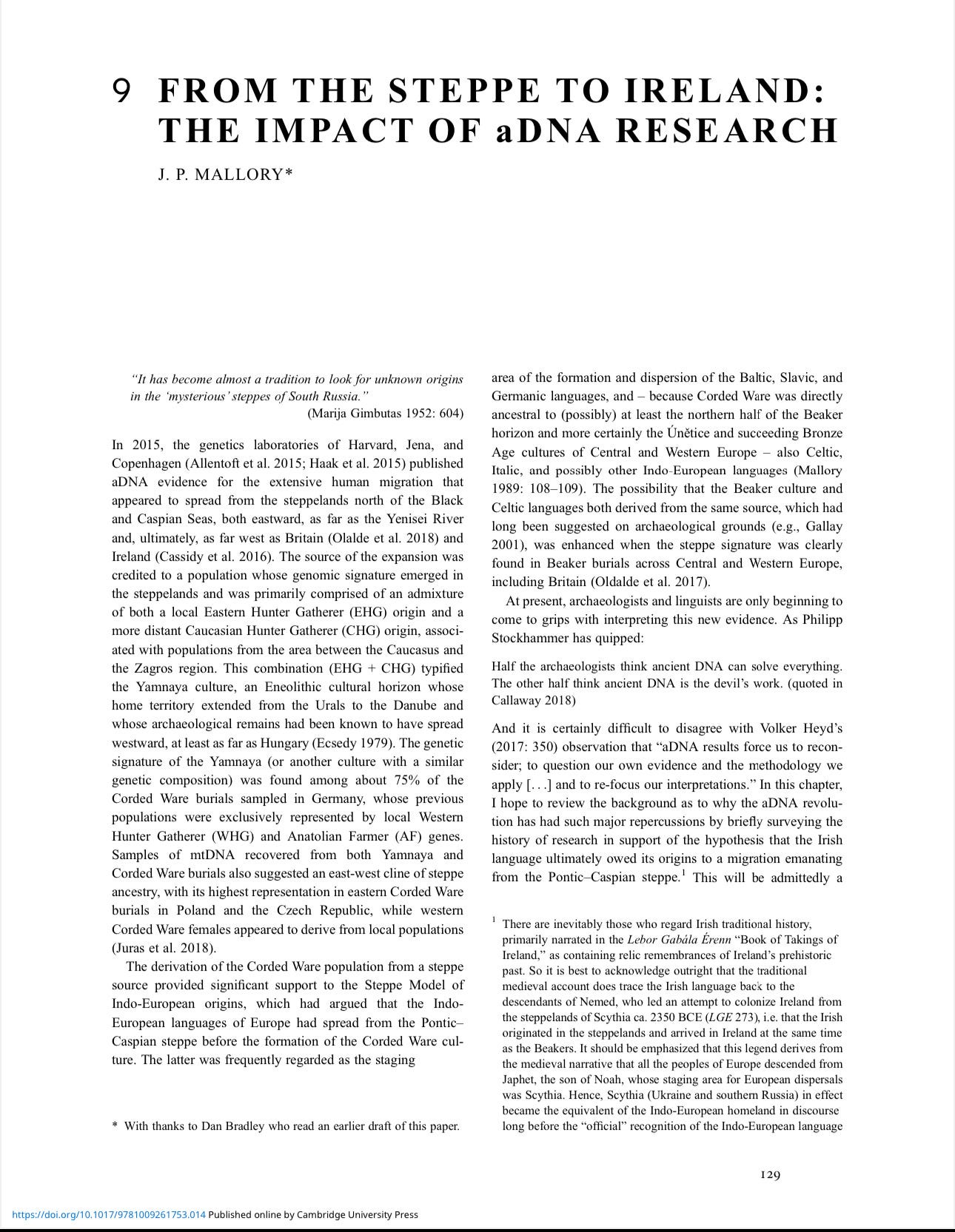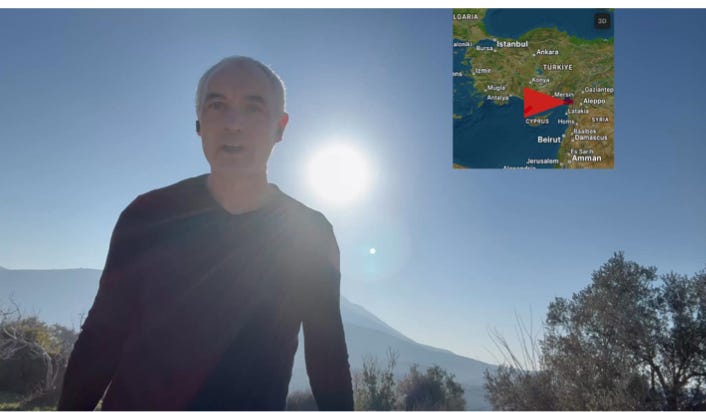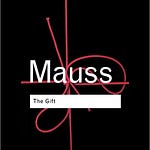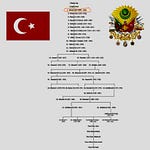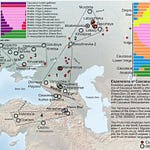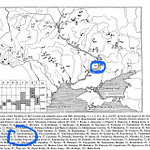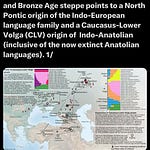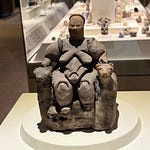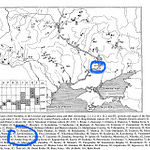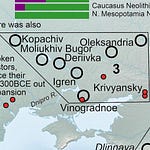Deity, Death, day, *Tiwas (Germanic deity who gave their name to Tuesday),… all derive from the Ancient Ukrainian word for sky *Dyeus. That’s right: when you say someone is ‘dead',’ quite sweetly, you’re saying, ‘they’re in the sky.’
If we can trace that sound and meaning (*Dyeus meaning sky) into every branch of the Indo-European / Ancient Ukrainian language family, then, that’s proof of concept:
Ancient Ukraine’s Don-sounding Rivers, Yama, and Lords of Death
The similarity between the moniker Donn (Ireland’s pre-Christian Lord of Death) and the names of rivers which embodied Gods, Lords of Death and the passage to the afterlife across the Indo-European cultural zone may be significant.
It’s definitely possible we might trace the M-N- sound too from Ancient Ukraine between 4,100 BCE - 2,500 BCE into every branch too.
As Finding Manuland unfurls, our journey across Manuland (which begins in 4,100 BCE with the Yamnaya Culture in Ancient Ukraine between the Don, Donets, Dniepr, Dniester, and Danube rivers across the space between Ireland and India until today) will demonstrate that M-N- is even more fundamental a sound and meaning than *Dyeus and death itself.
Earliest example of writing in Ireland is LOGIDEAS written in the Ogam script on a stone at Thomastown in Kilkenny. LOGIDEAS is a written remnant of the pre-Christian Irish deity Loigodēvā who was embodied by the River Loígde (which the English renamed the Bandon - coincidentally echoing Donn Irish culture’s pre-Christian Lord of Death and grandson of the monarch of Scythia / Ancient Ukraine)…
Hi there, welcome to the Power of Mana podcast. This is the Finding Manuland version of the Power of Manor podcast. This is episode three, a bit of housekeeping. So you're all part of my journey understanding this new amazing medium with lots of potential, which I think is the best means I have available to me at the the worldview and the Finding Manuland concept of history, culture, language in this moment. And so thank you for being along. So this is episode three. In time, you will see everything appear on the proper website, on the powerofmana.net website with the proper numbering. So just bear with me at this.
Mount Ḫazzi, the Hittites’ Mount Kassios
Following in the footsteps of the Hittite emperors and empresses, Decoding Trolls makes a pilgrimage to Mount Ḫazzi on the Syria/Türkiye border. Decoding Trolls narrates his visit to Ḫazzi, or as it is written in the bible Mount Zephon (Saphon in Greek), the most sacred mountain in Hittite religion.
So I've said to you before that every episode of the Finding ManuLand podcast will comprise three elements. And these three elements are about mana, MN, this MN sound, which is immanent. in our language in almost every sentence i speak in the podcast itself but also almost every sentence you hear out out in the outside world it's in immunity it's in communal it's in community it's in moniker it's in manus the mythological founder of the germanic people it's in manu the mythological founder of uh the indian uh people of indian culture it's in Sapianta Manu and Angra Manu, who are the founders in the Iranian people.
It's in the moniker for Mananan Maclear, who's one of, who's the preeminent pre-Christian God in Ireland. so we've got this mn sound which i am communicating to you means energy that's our hypothesis our standing focus so every episode deals with this aspect of human mn in human as well this human communication where we are constantly exchanging energy with our brethren with our fellow human beings, but also other sentient beings, our animals, anima, which is a reversal of the MN, and animal and animate, and manes, which is the soul in Latin. And... We exchange this energy as a function of being human.
It's from the micro, so it is from the cellular level. Our cells, our mitochondrial DNA code for this aspect. The energy which is created within each of our cells is coded for by what we today call mitochondrial DNA, which is passed along the matrilineal line, the feminine line.
Not only is this one aspect of being human that we really now understand on a micro, almost quantum level as being coded for, and we have a mechanistic explanation for it and understanding of it, we can conceptualize it, but it's also on the macro. So we have sacraments, we have matrimony, we have all of these words that, which have this sound imminent in them, in the modern English language. And my starting point was trying to wonder what is going on here. Is there anything going on here? What is the pattern here? So each of our episodes is dealing with this element, and MN is in element itself. An element itself contains two elements.
It has the alu, ele, light, which is shining through aspect, and the munt, the munt, the MN, sound which is about the energy so it's the energy shining through it's the light shining through the energy it's like the moon it's like the light shining through the shape of the moon or as we understand it reflecting off the moon and so you have this yin and yang we have this light and darkness we have this shape we have something shining through something else and this is the word we have in modern english called meaning again m n sound so meaning a meaning is something other shining through something else. So we have this whole network of meanings and signifiers of which all of our language is made and consists of. So this is the kind of a mystery. This is the, it's more of a phenomenon, an MN as in phenomenon, that shines through our entire human culture. But for me, and maybe for you, because you understand these words, I'm speaking to you in an Indo-European language. For us, it's a particular shining through. It's this MN shining through. So we're looking at this pattern in today's world and looking backwards to see how has this arisen?
What does it mean? Is it just random or is there something a bit more to it? So every episode is looking at this energy, which we exchange as a function of humans and I want to remind myself and all of us that when we're interacting with people, with other beings, that actually what's going on, despite the words or the emotions or the motivations or the attitudes, the intentions, the moods, we're disclosing and exchanging that really what's going on here is an exchange of energy so that we can focus ourselves. on what matters, that we are humans today, exchanging energy like inside our bodies are trillions of cells, constantly exchanging energy with themselves.
And then when we interact with the external environment, we are also exchanging energy, not only with the environment and what we would call inanimate objects like stones, but mainly with Other sentient beings, including humans and animals, with whom we have this relationship of equals in a way, because what we are actually doing is exchanging manna and energy and the remnant of the memory of beings. This important function of our capacity of as humans is this MN sound in Indo-European languages. In different other language families, there may be other sounds. And I have a few ideas about that, but nothing fixed because I don't speak any non-Indo-European language. uh languages and i just happen to spot this mn phenomenon in indo-european culture and that's what i've spent the last few years journeying on so this first thing is we have this energy this manner in each episode but we also have this language because the mn is a form of language it's a sound It means something in different forms, in different words. So the Power of Mana, the Finding Man Who Land podcast is also a journey through language. And it's also a journey through space and time.
And so this is the third element, the third dimension of the Finding Manu Lamp podcast. So we are starting off in today and we notice this phenomenon of the MN sound and we're thinking, wow, how's this arisen? Why is it that Manus in Germanic culture, he's got the MN in his moniker.
Manu in India has an MN in their moniker. Mananen in India. In Ireland, a Celtic culture has that MN in their moniker. Manaudan, another Celtic culture in Wales, one of its mythological founders is Manaudan. And we have all of these different linguistic cultures with this... important manifestation of this MN sound in the mythological founders, monikers.
And then we notice in the language we speak, almost every sentence we speak, we've got this MN sound which occurs in certain key vocabulary like the word meaning. And we try to discover, well, how could this have arisen? Is this borrowing that Celtic culture borrowed it from Germanic culture or Germanic from Celtic culture or Indic culture borrowed it from the Germans or Germanic? from Iran, and Iran borrowed it from Ireland, or how did this happen? And then we look, is there archaeological evidence for these kinds of exchanges of, not just of energy, but actually of energy really manifest by the coincidence or the borrowing or the separate invention of the this important sound, which is not only the sound, it's not only the sound of MN in these monikers, in these words, in these meanings, it's also the associated meanings. So the first human in Indian culture is Manu, the first human in Germanic culture, and MN is in Germanic because it comes from, it derives from Manus, the first human in Germanic culture is Manus, The preeminent god in Irish culture is Manannan. And Eremon is the first high king of Ireland. Eremon, M-O-N, in there. Then we look at all of these toponyms. The names in Ireland is about three, four, five thousand toponyms. We'll come to this. which have the MN sound in them. Some of us will be watching with great joy, slight trepidation obviously, but mainly great joy, the liberation of Syria from the Assad clan and many of the names of the places in Syria or what it was called Assyria. have this MN sound in them.
And these are very much part of our story because of the importance in our story of Anatolia, which is today's Turquia, where we have this interaction zone between Anatolia and Assyria, this interaction zone between ancient Egypt, between the Mitanni, which is an between the Hittite, which is probably the greatest Indo-European empire, maybe until what happened in Europe after the 1800s. And we have this interaction zone between the Indo-European, between the Egyptian and the Semitic. The Assyrians are a Semitic people. And in Judea, we have this interaction. Long before the Bible, half a millennium at least, we have evidence. We have archaeological evidence of interaction between what we now know as the Indo-European people, the ancient Egyptians, and the Semitic peoples, who would then become the Assyrians, who would then become the Jewish community. And we have archaeological evidence from the Amarna letters from ancient Egypt, which are from 1400 BCE, which demonstrates, which proves that we had Indo-European monarchs in areas of what is today's Judea and Palestine. And for us, in fact, in Finding Manuland, this idea of looking, so the Bible itself, the Bible which the Christians use and people of the Jewish community use, uh itself would began to be formulated well the events it describes really uh king David the historical king david and the historical king solomon and let us remember that king david's his grandfather was uh a hittite was an indo-european and dea devas is what this episode is going to really be about so it's good we're talking about and then solomon we've got the mon element and solomon who's the the second king in Israel, the historical King David and the historical King Solomon monarchs are around 1000 BCE. But this is the element, the third element in every Finding Man and Man podcast is this journey. I'm going to take you on this mental journey, this journey through your mind, which is going to hopefully transform your mental geography as it has and is transforming mine. So that in our minds, when I started out in this journey... The Bible, biblical era, maybe 1000 BCE, was about as early as my mind went.
And for a long time, and for a long time in history, this was seen as the beginning of history. And then prior to that, we had what we call prehistory. But actually, the finally Manuland perspective, which I am inculcating into our minds... looks at the 4100 BCE.
So the journey from, the temporal journey from 4100 BCE, six millennium, again, MN. In millennium, there's so many of these spatial concepts which have the MN sound in them, which emanate, and this is key in finding Maniland, from Menyot, which means moon. And Menyot contains two elements.
MEH1, which means measure, and then nyot, which we will come to in later episodes. And so between 4,100 BCE, in an area of ancient Ukraine, southeastern Ukraine, Mykolaiv Oblast, which is the type site of the Yamnaya, again M-N in Yamnaya, between 4100 BCE and 2500 BCE.
So that's a chunk of time that most of us don't have in our minds. But by the end, or as Finding Manuland develops, We will populate this chunk of time in our minds with many different events and concepts and phenomenon. Because it's a really phenomenally, both literally and metaphorically, important point of time.
Because between 4100 BCE and 2500 BCE, in an area of southeastern Ukraine, between the Don River, which is part of Ukraine's historical lands, ancient Ukraine's historical lands, the Don River... historically determined the borders, the boundary between Asia and Europe, between the area where the goddess Europa, who started their life, as a provincial deity in a part of what we now know as Greece, but gradually their patronage and their coverage spread all the way over an entire continent. But their bailiwick... the limit of their protective embrace was the Don River. And we know this from, and I will post this map we have from Isadora of Seville, who will be a character in our story as well, from around, I think it's around 500 BCE, Christian era, where Isadora of Seville's etymologies, which was the Wikipedia, the Encyclopedia Britannica, of perhaps the Finding Manuland, he says modestly, of the ancient world, of the time. There's this story in the Irish mythological record where...
The entire, this famous book, which is missing, we've got elements of it. It's called the Book of Dhan Shnakta and that's Drum Shnakta. And that book contains many of the purer remnants of the Indo-European inheritance itself. in early Irish culture, as mediated through the Celtic language family.
And now we've got bits of it, but we don't have the whole book. And one of the tragic stories in the history of Irish culture is that a group of monks who possessed this book, they swapped it for Isidore of Seville's etymologies.
But in Isidore of Seville's etymologies, one of the elements in it is the map of the world. And this is where we are shown the Don River, the Tane, the Dane River, as being the limit of Europe. And the Donets River, where I was when I discovered the power of manna, working as a diplomat between 2015 and 2018. And then the Dnieper River. So I'm bringing your mind here from the Don to the Donets, now to the Dnieper River, the Dnieper, which it's today, it's called the Dnieper. Some people in English call it the Dnieper River. Anyway, I won't get into that.
But it's the Dnieper River, and that breaks down as Don Iper, height, the higher Don River. And so you have the Don Iper, you have the Don, you have the Donets, the Don Iper. Then we have the Donister, the Dnieper River, Donister. So I'm bringing you right across contemporary Ukraine today.
And then we go further west and we get to the Danube River. So here we have some of the great rivers of Europe. The Don, the Donets, the Dnieper, the Dniester and the Danube, which coincide with the whole of Ukraine. And this will be part of our story as well. The DN sound is important.
And we'll come back to why. It's not only important as a part of my story that I'm telling you of my journey to find Manuland, which began... Well, I worked as a diplomat in Ukraine, and I also worked on the Dnieper. I lived in Dniepro between 2018 and 2022 in the full-scale invasion. And the mound, the burial mound, the Yamnaya burial mound in the outskirts of Dniepro, which I came across as part of my work in May 2021... is one of the starting points for finding Manuland and a journey which it has brought me on to realise that actually the whole Indo-European language, religion, culture, outlook... that we experience today between Ireland and India, which are the traditional Indo-European lands between Ireland and India. And obviously now Indo-European languages are spread to the Americas and to other parts of the world. But the traditional area between Ireland and India, that is the area I call, I use the moniker Manuland, because in our minds we don't see this area as... We see Europe as one place today, but as I've just alluded to, the goddess Europa, who started off as a provincial deity, and with Zeus, who is part of our story today. And in the same way, I'm trying to spread our mental models of...
Rather than having lots of individual countries between Ireland and India only, we now have an identity as Indo-Europeans that we can define ourselves positively with, that we have differences, each of us in different cultures, whether we are Indian or Iranian or Irish or Tajik or Armenian or...
or german or greek or ukrainian or polish or spanish etc or french we have all these separate identities but we also have this common identity and the common identity is grounded on our common language we speak a language that emanated from this group of yamnaya people in this area of southeastern Ukraine between these great rivers, the Danube on the western side of contemporary Ukraine and the Don on the eastern side of contemporary Ukraine. And in a particular area, Mikolaev Oblast, where Russia and Ukraine are currently fighting each other, in the very space, in the very islands. So you have the Don Iper River there, a very wide river. I mean, unbelievably wide river for those who come from countries like I do with long rivers, but not wide rivers. And on this, there's just this massive numbers of islands and it's very hard to cross it. And every day there are these battles happening. Extraordinary battles there using drones, submersible drones, buried mines, fighting starving Russians and fires.
And this is the very interaction zone where... In the miracle of miracles, one language family was forged, which then took over the world. It spread from 4100 BCE to 2500 BCE. It formed there and it spread from Ireland to India. And that is the amazing miracle we're really concerned about in Finding Manuland, because when you see all of these coincidences between this MN sound and the meanings over time and in different cultures, you then always asking, is this borrowing? Is this separate invention? Or is this a coincidence? Is it a pattern that means nothing? And then as I was investigating this and I then discovered the existence of the Indo-European family, which I was only really dimly aware with and didn't really understand too much about it and what we could know about it today, given, Given the analysis of ancient DNA using mitochondrial DNA, remember I mentioned before that each of our cells, each of our complex cells has two different genomes.
One is the nucleate genome, which is just massive. It's the huge one. It was the famous one, the one that they were trying to decode at the turn of the millennium and we thought it was going to change everything. But then there's the other, the mitochondrial DNA, which is passed along the matrilineal line.
And it only has about 32, 33 genes in it. And that's what codes for the energy production in each of our cells. And ancient DNA, the ancient DNA revolution, which was launched in... In 2015 with this Nature article. So it was at a time I was in eastern Ukraine.
And this article in Nature determined the signature of what it calls step ancestry. But what I call and what we call in Vanyumanulan ancient Ukrainian ancestry. Because now we know through various sources, and we will get to it again, from various different evidence lines, whether it's archaeology, linguistics, and now looking at ancient DNA information through mitochondrial DNA, we know that in fact the Yamnaya are not just steppe. They're not from the Pontic Caspian steppe or southern Russia or this vague area you will see in some of the, most of the literature, even to today, that the steppe, the signature of steppe ancestry was determined in this Nature article that you could then use this signature as, you could look at ancient DNA and go, okay, this has X amount of ancient DNA from this particular geographical area. And so this step answer, so then when you look at this literature and you find out, okay, actually there's a physical, this physical scientific evidence today, material evidence of migrations from this area that, to Ireland on the western zone, and to India on the eastern part. And we have these coincidences of meaning and sounds for the same kinds of concepts. We have this phenomenon that in every Indo-European language... We have this MN sound is in the words we have for time, temporal.
So in English we've got moments, month. We've got the moon is obviously very, very important. We've got Monday. We've got millennium. there's a whole panoply of them. And we can trace this back to the word, to the sound and the meaning that the first Indo-Europeans, these Yamnaya in ancient Ukraine, these ancient Ukrainian Yamnaya, the first Indo-Europeans between 4,100 BCE and 2,500 BCE, used to describe measure, so menyot, And that became the word for moon, for the moon, the measuring instrument. And so that's one trajectory of meaning, one vector of meaning that is still alive today in every Indo-European language. And we have... This is not a mystery.
Well, I mean, there's lots of mysteries still, but this is not... It's not borrowing. It's because it comes from a common, and MN is in common as well. It comes from a common source, and the common source we now know through archaeological, linguistic, and ancient DNA analysis, this common source emanates from this part of eastern Ukraine, of southeastern Ukraine, where when the Yamnaya who forged the first Indo-European language that many of us aren't aware of, and I certainly wasn't aware of it. And believe me, like the moment I discovered this, it was just, well, I didn't believe it at first because what are the chances that me randomly ending up in Ukraine and randomly embarking on the journey. I was there in Eastern Ukraine as a diplomat, helping to monitor the peace, the Minsk peace process between Russia and Ukraine between 2015 and 2022. What are the chances that while they're in this place that I always considered, Ukraine wasn't really part of my mental model.
And in most of the mental models of Europeans, Ukraine is still on the periphery. what are the chances that I would discover this place that I thought was on the periphery is in fact, is in fact the battery. It is the power, it is the center of what powered these huge migrations that were so successful that they seeded the same language between Ireland and India. And what are the chances of me in 2015 ending up in this place and discovering the power of man as... imminence in our language, in our mythological cultures, and in our identity and function as humans and sentient beings, And then actually being in the place where this began.
And so finding Manuland is this journey. It's a mental journey. It's temporal between 4100 BC to 2500 BC. Because that is the moment we now know. And I'll go into the reasons how we know this. Where Indo-European languages were germinating. And then from 2500 BCE, the Western Indo-European languages, so the Celtic language, the Germanic language and English.
I'm sorry to say any English listeners who didn't know this, I didn't know this, even though English is my native tongue. I am an Irish person who lives in Ireland, who has a Celtic consciousness. whose forebears would have spoken Celtic languages, but now they speak a Germanic language, an English language.
So that's a journey in my genes, in my genome, in my cultural genome. But the Western Indo-European languages, so the Germanic, the Romance, which emanate from the italics. So there's this place... near just east of Odessa, the modern city of Odessa along the coast, where it is believed this Usatova, the combination of this Usatova community and the Yamnaya community, they forged... The Italic, the Celtic and the Germanic language, linguistic and cultural families were forged out of that interaction in that geographical space. And I don't know about you, but I just find that fascinating.
So the, you know, the acorn out of the, rather, the oak tree out of the acorn. So the acorn is there, is in that spot. We still don't know that. did the Germanic language family and the whole of Germanic culture. And by this, I mean the language, I mean the outlook, the mythological history.
We don't know, did that come a bit later or earlier? But what we do know for sure is that the Italic and Celtic language were one community. And then probably the mechanism was through migrations of part of that community went one way and the other part went the other way.
And so all that we know of ancient Rome and Roman culture... And all that emanated from that, the Romance language, Spanish, French, that emanated from Latin, from the Italic culture, all of that began its life in ancient Ukraine and in a relatively small area, which I've travelled around and travelled through, sadly before I understood this,
And I just think that's amazing. And so finding Manuland is about discovering that we know these things, understanding how we can know these things. So I encounter these ideas first and then I'm like, how could that be? And I spend, I've read thousands of texts over the past few years and that's what I'm sharing with you here.
And then, so all of those languages, came after 2500 BCE. But the significance of the 4100 BCE is that what we call the Anatolian branch of the Indo-European languages emanated from that area and ended up in what is today modern Turkey, and Anatolia, and established a foothold there then. And that, I'd just like you to have this concept in your mind that there's two main branches of the Indo-European language family. One is the Anatolian, and the other is all the others, really. And then there's sub-branches there of the Western language, Indo-European languages, western of ancient Ukraine, so Germanic, Celtic, Italic, Slavic, Scandinavians are Germanic, and what have you.
And then the eastern, which is basically what they call the Indic branch, which contains Iranian and Sanskrit, and today's hint, which developed into Indian. Hindi and Tajik and all of those. So those branches themselves come after 2500 BC. And the Anatolian is around 4100 BC.
So I'm going to just look at... We can trace this through words and through meanings. And this, the meaning of death, which today... So the meaning of death... is literally to the sky. So when you say someone has died, what you're really saying is someone has gone to the sky. And how do we know this?
We know this because there's only one word for... There's only one religious word which appears in every single Indo-European branch. And so... Normally we know if a word and a meaning, if a sound, which is a word and a meaning, appear in one Indo-European language, say Germanic, which is west of Ukraine, and the same sound and meaning appears in an Indo-European language east of Ukraine, say in Sanskrit, which is an ancient Indian language, then we know on the balance of probabilities that it might be from the common source. It could be borrowing. So someone from early German culture might have met an Indian person and somehow seeded this entire concept. But when we come to something like, say, manus, M-A-N-N-U-S, which is in the sound Germanic and hermiones, the first German. When we have Manus as the mythological founder of the Germanic people, and we know from Tacitus, who's a Roman writer, writing around, I think it's about 98 years into the Common Era, who's our source for the early German culture, we know Manus existed as a concept then. And then we know Manu existed, Manu is the first human in Indian culture, and our source there is from about 1100 years before the Common Era, then there's something with this MN in both those monikers, and it's unlikely that one Indian met a German around 50 years into the Common Era and said, oh, you know, our first human is Manu. Why don't you call your first human Manus? Manus. And the German person goes, yeah, yeah, yeah, great. And then the German person convinces everyone in the Germanic, the 10 Germanic tribes, historical Germanic tribes, so the mythology goes, to call their first human Manus. And this is what will bind us together as Germans. That... That just sounds implausible to us. What is much more plausible is that this comes from a common source. And then when we discover Germanic and Sanskrit are both Vedic, which is the first language that Manu appeared in, in the Argy Veda, which is first written down or first composed, first written down around 1100 words. years before the Common Era, but was probably composed over the prior millennium and just in songs. So Manu existed very early. We've got evidence there existed very early.
We have no evidence of sustained intercultural contacts between people in India, on the Indian South Continent, and people where the Germanic peoples lived. So we know on the balance of probability, the MN sound and the moniker Manu, Manus, probably emanates from the common source. But there's two sources.
And then we have, for instance, Manawadon and Manannan in Ireland and Minos and Greece and all that. And we'll get to all of those. So I'm just trying to illustrate how... On all other things considered, if you've got a sound and a meaning which exists in one Indo-European language, east of ancient Ukraine and contemporary Ukraine, and the same sound and meaning which exists west of Ukraine, you know you're probably coming from a common source. But in the case of this word, dies... it appears in every Indo-European language. And it's the only theological, it's the only word, religious word, that exists in every single Indo-European branch. So it's so entrenched that the Yamnaya, it's so entrenched that the Yamnaya between 4100 BCE and 2500 BCE in ancient Ukraine, It must have been on their minds. It must have been the most important word on their minds because they carried it through into all their descendant people. And by descendant people, I don't just mean today we can chase, we can trace the genetics, the ancient genetics of this steppe ancient Ukrainian gene, genome, and the particular part of it. into the Brahmin DNA of the Brahmin in India. And again, MN and Brahmin. We can trace it into the Flamines and all of the priestly people in ancient Rome. And now, believe it or not, and we'll get to this again, we can even trace it into everyone living in the island of Britain in 2450 BCE. And my source for this is Nature, which is the preeminent scientific journal and an article which it published in 2019. And now since then, we've discovered that actually, despite the myth or the mythical history or the hope, the island of Ireland also got this step gene. around 2450 so we we can trace the the material remnant of this migrations in our genome but there's also i'm talking about the cultural uh descendants so so often people sometimes peoples who are not genetically related using the latest dna techniques so there's no they did not descend from each other genetically but they did change the language so sometimes uh I mean, the model, the elite changes the language of the entire culture, the entire community. And so that's why we're talking about this, this descent. And so we've got this, this sound, meaning sky, bright sky in the first Indo-European language in ancient Ukraine. and shining sky bright sky and so between 4100 BCE and 2500 BCE we know that this was the idea of the sky and the sky father sky protector so dies pater in in in that language I've mentioned this before in episodes and that becomes Zeus pater who is the preeminent monarch of the sky, sky father in ancient Greek culture. Jupiter, Jupiter, Zispater, Zupater in Rome, in ancient Roman culture. And there's a Diapata in early Indian culture as well. So this bright sky, bright sky. And so when you say someone is dead today in modern English, what you are literally saying is they've gone to the sky. And I think that's quite sweet in a way. It's quite nice in a way. But imminent in that is a whole ideology and religious ideology. Because my starting point for finding Manuland in a geographical spatial way, one of my main starting points, I've written about this and I'll speak about this, is this mound, this burial mound, this Yamnaya burial mound, which property developers in a suburb of Dnipro uh destroyed uh on a lot we're using the they said they were researching it but really they were just trying to destroy it so they could build a new mansion uh for mn and mansion for or domain for uh for an oligarch in the outskirts of dnepro in the smart and it was The local community protested against it, which me as a monitor, as a monitoring officer for the OSCE in eastern Ukraine, my job was to monitor any national security related issues, protests and the like that might spark some more significant conflict. And there was this group, civil society organization in Ukraine called the Mound Guardians, the Kurgan Guardians. And they were quoted in the New York Times. Their leader was quoted in the New York Times as saying, this is an aspect of cultural genocide to destroy one of the 100,000 burial mounds of the Kurgan people, of the Mound people, the Yamnaya people. in order to build a mansion for an oligarch, and pretending you're researching it. This is part of the destruction of our heritage. And they said this is a national security issue.
So I discovered this... existence of the Yamnaya through the destruction of this mound to try and work out what is going on here. What is this? It's a 5,000 year old burial mound. There was a number of humans buried in it.
And one of the earliest burial in it was of a human who was a monarch with crouched knees and covered in ochre. And I saw the pictures and I went to this place and it turned out when the property developers destroyed the mound itself, underneath it was a stone circle.
And the stone circle had been created by precursors to the Yamnaya people, what they called the Stredni Stog people, middle stack, literally. It is out of the interaction of the Yamnaya and the Shredni Stog that the Indo-European languages were born. And this particular burial mound was so special because what it was was you had the Sredni Stog buried their dead. in communal graves with very few or none grave goods and then suddenly you have this switch into the burial of one male masculine monarch on their own with this massive mound which would have been built using huge communal work to the whole community who's coming together to build this mound. I mean, these mounds, there's 100,000 of them still in Ukraine, across Ukraine, and they feature part of our story because we can trace the migrations from Assyria. And this idea of burial, this religious idea of being buried under a mound, which usually it seems to signify the underworld and is related to Skyfather and a whole set of beliefs,
Mount Ḫazzi, the Hittites’ Mount Kassios
Following in the footsteps of the Hittite emperors and empresses, Decoding Trolls makes a pilgrimage to Mount Ḫazzi on the Syria/Türkiye border. Decoding Trolls narrates his visit to Ḫazzi, or as it is written in the bible Mount Zephon (Saphon in Greek), the most sacred mountain in Hittite religion.
which we might be familiar with if we're Christians, of this idea of heaven and the patriarch Zeus Pater in heaven. And this whole journey, which many of our Indo-European cultures went through, where you start off with Skyfather, around that time, early in the early part of the culture, then your heroes die and they go to the sky.
Then by the time we get to our more egalitarian cultures, in many Christians' beliefs today, everyone goes to the sky when they die. Everyone goes to St. Peter, again, Peter Pater, who weighs the stones as you die. And so perhaps now when you hear the word death death and and fear is in your mind and in your heart you'll remember this um there'll be a reminder in your mind mn in reminder as well there'll be a reminder in your mind that finding manual land is going to bring you on journeys through language culture time metaphorical journeys journeys my journey from this time in contemporary Ukraine from 2015 on, so the short Jure, but then the long Jure from 4100 BCE until today, as well as journeys through our cultures, so our cultures across this place I now call the moniker Manuland, which we didn't have a word for before, which we didn't have a moniker for, where we speak Indo-European languages, from Ireland to India, and also journeys inside these cultures where we find the commonalities in them, which demonstrate this MN sounds immanence in many of the most important and fundamental phenomena, whether linguistic or cultural, or mental phenomenon in these cultures and this is what finding manu lands about so that is the meaning of death which we'll come back to again because it's not only important in our own minds because death death defines us in many respects. And the burial customs we use are one of the main means that archaeologists have used to determine the differences between cultures. So before we had ancient DNA analysis, we knew who were the Yamnaya buried from their burial customs? There was about 22, 23 common aspects of particular burials that we could trace between Ireland and India and say, oh, these are part of the same archaeological culture, which we now know as Yamnaya, that became the Beaker people in India. in England, which for any of us over that generation who watched the Muppets, thinking of Beaker and the Beaker people, it's very helpful. It helps perhaps personalise them or make them seem like warm people, but the Beaker people whose genes contain the ancient Ukrainian Yamnaya genes, and most people in England today emanate from the Beaker people or some function of them, whether they came with the Germanic migrations, with the Saxons, with the Normans, again, MN, Normans, with the German invasions from Denmark, that DN is in Denmark, which is, we'll come back to that, the DN, the Don, the Dnieper, the Danube.
So there are other important sounds in Indo-European languages which we'll talk about, but the MN sounds, immanence, in so many of the most fundamental and important concepts is what really ties the organising focus of our entire Finding Manuland project. And the easiest way I explain why the MN sound is so important is because it's in meaning.
If we don't have a meaning, if we don't have a concept of meaning that A can mean B... then we don't have a language. And MN even populated, colonised this very complicated idea that you can have one word with another meaning shining through it and that other, like the moon, like the light shining through the moon shape or the moon shape shining through the light. And without that, that the light shining through is another word, which itself depends on another word. And you have this whole network. of words but this MN sound I maintain is the fundamental sound in our entire culture and that's what's led me to understand the meaning of death the lords of death which is something we'll come back to because it's very important to trace who are the lords of death whether it's Odin in Germanic culture or Yama in Indian culture or Aryaman in In Iranian culture, this function, this person who looks after the death process, who's the first human to die, the first monarch, the first king to die, and who leads us all through, is buried in a mound, in a burial mound, and they lead us all on this journey. All of us will eventually travel on in this form to death and to the sky but let me leave it with that so death next time you hear death just think this just means going to the sky and that can't be too bad.
Continued:
Ten Reasons Why Finding Manuland Matters - Vol. 1 - Episode XXXIII
Today, we’re looking at how the Finding Manuland iterative method of discovery works. And, we look at the first two of ten reasons why Finding Manuland matters.
Continued from:
First episode:
Finding Manuland I
In October 2021 I was returning from my final vacation before my forced retirement from my beloved diplomatic posting to Ukraine.
Mount Ḫazzi, the Hittites’ Mount Kassios
Following in the footsteps of the Hittite emperors and empresses, Decoding Trolls makes a pilgrimage to Mount Ḫazzi on the Syria/Türkiye border. Decoding Trolls narrates his visit to Ḫazzi, or as it is written in the bible Mount Zephon (Saphon in Greek), the most sacred mountain in Hittite religion.



